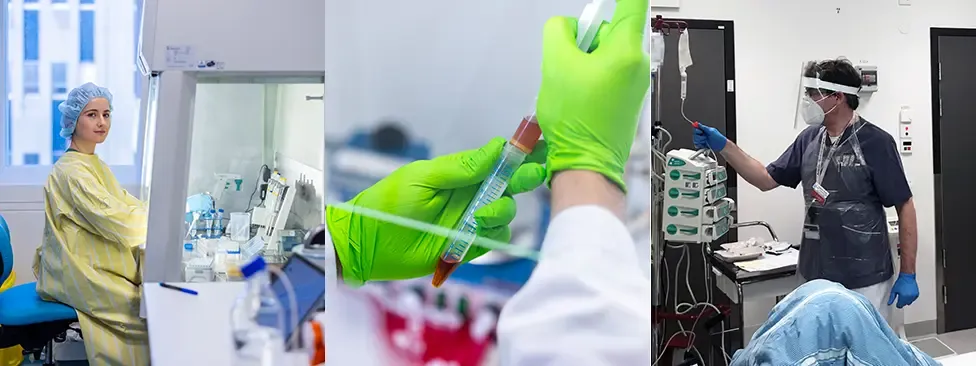Knut Steffensen heads up the newly opened Karolinska ATMP Centre, which has been established to convert research on cell and gene therapy into actual treatments. Equipped with experience from both academia and the pharmaceutical industry, he wants to combine the best of both worlds.
Knut Steffensen weaves together the personal and the professional when talking about his new role as director of the Karolinska ATMP Centre . He has 20 years' experience of university life and Karolinska Institutet, as docent of molecular biology and research group leader.
On top of this, he has worked for eight years in the pharmaceutical industry, where, amongst other things, he introduced CAR T-cell cancer therapy (a form of immunotherapy) into hospitals.
Motivated by personal interest
He has also lost a young sister to cancer, and has a son with Schuurs-Hoeijmakers syndrome. Cancer and rare genetic conditions are both areas in which cell and gene therapy can offer new therapeutic possibilities.
"I have personal grounds for wanting to work in this field," he says. "What I hope is that we'll be able to offer effective, curative treatments for cancer and to detect and treat genetic diseases at an early stage of their development," says Knut Steffensen , docent at the Department of Laboratory Medicine .
While in charge of the ATMP Centre, he will be leading efforts to realise this vision and take call, gene and tissue therapies from the laboratory to the hospital. The centre is a joint initiative between Karolinska Institutet and Karolinska University Hospital and is based in Flemingsberg.
Preventing siloing and identifying bottlenecks
ATMP stands for advanced therapeutical medical products, and covers a group of drugs based on genes, cells or tissues that offer unprecedented possibilities for individualised treatments. Such drugs have already greatly improved survival for patients with blood cancer, and intensive research is in progress on solid tumours and rare genetic diseases.

The ATMP Centre was set up to accelerate developments and to serve as a link between the different necessary functions in an environment that gathers research, manufacture and treatment under the same roof.
"Karolinska ATMP Center possesses a vast resource of knowledge on which to build," says Dr Steffensen. "We've already got all the ingredients we need and excellent infrastructure, such as the clinical trials unit and Vecura, our ATMP production facility."
He describes the centre as a virtual hub that brings together researchers, clinicians and people from the pharmaceutical industry. It has two primary purposes: to prevent siloing and to identify bottlenecks along the chain.
"Taking research to clinical trials is a very complex process that requires a lot of planning," he says. "I'll try to open doors along the way and erect structures and processes to facilitate our work."
Another challenge is financing. Drug manufacture and clinical trials are both costly.
Knut Steffensen hopes that the ATMP Centre will one day become a contact interface with the pharmaceutical industry for collaborating on and co-financing projects. At the same time, they are building structures that researchers can use when applying for grants.
From science fiction to science fact in 15 years
Dr Steffensen sees his combined knowledge of academia and of the workings of the pharmaceutical industry as one his most valuable assets as head of the centre.
"I know how the various organisations operate," he says. "As a researcher, you're used to running your own projects, whereas in the industry you work in teams without regard to self-interest. The industry is also better at identifying business-critical issues and getting them solved. Combining the different approaches is, I believe, the way forward."
During his career, he has been engaged in the development of cell and gene therapy from what, fifteen years ago, was seen as science fiction to what is now clinically applicable science fact. As the director of the ATMP Centre, he is keen to take the collaboration between research, healthcare, politics and industry to the next level.
"Hospitals and politicians need to be prepared for the treatments that are on the way and what they're going to need by way, for instance, of bed numbers," he continues. "At the end of the day, it's the politicians who set the hospitals' budgets. The industry can also contribute if we can find ways of cooperation that benefit all parties."
The potential of the therapies is almost limitless, according to Knut Steffensenm, and by the next five years he hopes that there'll be many promising projects from Karolinska Institutet ready to go to clinical trials.
"If only a small per cent of the research projects currently being done at Karolinska Institutet go the whole way, we'll be able to treat many serious diseases," he says. "This would be a real success for us, but above all for the patients."
The Karolinska ATMP Centre is one of Europe's leading ATMP research facilities, but as Dr Steffensen says, that does not mean that we can rest on our laurels:
"The world has woken up to cell and gene therapy. Continuing investment and strategic collaboration are needed if we're to stay ahead."
Text: Karin Tideström
Translation: Neil Betteridge
The Karolinska ATMP Centre in brief
ATMP stands for Advanced Therapeutical Medicinal Products. These are a group of drugs based on genes, cells or tissues and that offer revolutionary and individualised possibilities for curing diseases.
The Karolinska ATMP Centre coordinates research, development and production regarding tailored therapies based on genes, cells or tissues, and endeavours to link scientific breakthroughs with clinical application. Its aim is to develop novel, individualised therapies and accelerate the process from idea to treatment.
The Karolinska ATMP Centre is a joint venture between Karolinska Institutet and Karolinska University Hospital and a leading European ATMP centre that gathers research, manufacture and treatment under one roof.
Source: KI






